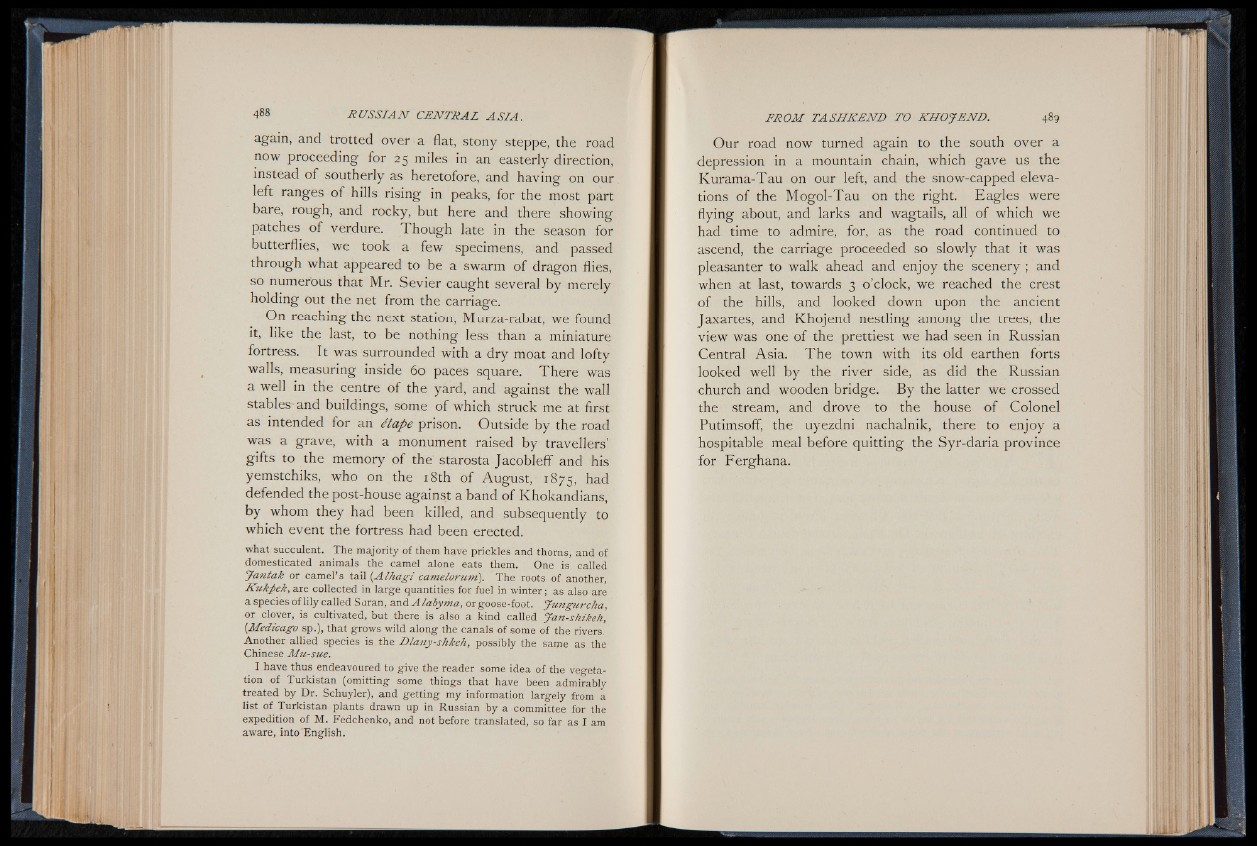
again, and trotted over a flat, stony steppe, the road
now proceeding for 25 miles in an easterly direction,
instead of southerly as heretofore, and having on our
left ranges of hills rising in peaks, for the most part
bare, rough, and rocky, but here and there showing
patches of verdure. Though late in the season for
butterflies, we took a few specimens, and passed
through what appeared to be a swarm of dragon flies,
so numerous that Mr. Sevier caught several by merely
holding out the net from the carriage.
On reaching the next station, Murza-rabat, we found
it, like the last, to be nothing less than a miniature
fortress. It was surrounded with a dry moat and lofty
walls, measuring inside 60 paces square. There was
a well in the centre of the yard, and against the wall
stables-and buildings, some of which struck me at first
as intended for an ¿tape prison. Outside by the road
was a grave, with a monument raised by travellers’
gifts to the memory of the' starosta Jacobleff and his
yemstchiks, who on the 18th of August, 1875, had
defended the post-house against a band of Khokandians,
by whom they had been killed, and subsequently to
which event the fortress had been erected.
what succulent. The majority of them have prickles and thorns, and of
domesticated animals the camel alone eats them. One is called
jfantak or camel’ s tail (A lh a g i cameloruni). The roots of another,
Kukfiek, are collected in large quantities for fuel in winter; as also are
a species o f lily called Scran, and A laiyma, or goose-foot. Jungurcha,
or clover, is cultivated, but there is also a kind called Jan-shikeh,
(.Medicago sp.), that grows wild along the canals of some of the rivers.
Another allied species is the Dlany-shkeh, possibly the same as the
Chinese Mu-sue.
I have thus endeavoured to give the reader some idea of the vegetation
of Turkistan (omitting some things that have been admirably
treated by Dr. Schuyler), and getting my information largely from a
list of Turkistan plants drawn up in Russian by a committee for the
expedition of M. Fedchenko, and not before translated, so far as I am
aware, into'English.
Our road now turned again to the south over a
depression in a mountain chain, which gave us the
Kurama-Tau on our left, and the snow-capped elevations
of the Mogol-Tau on the right. Eagles were
flying about, and larks and wagtails, all of which we
had time to admire, for, as the road continued to
ascend, the carriage proceeded so slowly that it was
pleasanter to walk ahead and enjoy the scenery ; and
when at last, towards 3 o’clock, we reached the crest
of the hills, and looked down upon the ancient
Jaxartes, and Khojend nestling among the trees, the
view was one of the prettiest we had seen in Russian
Central Asia. The town with its old earthen forts
looked well by the river side, as did the Russian
church and wooden bridge. By the latter we crossed
the stream, and drove to the house of Colonel
Putimsoff, the uyezdni nachalnik, there to enjoy a
hospitable meal before quitting the Syr-daria province
for Ferghana.